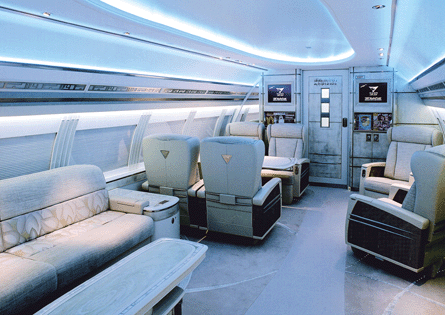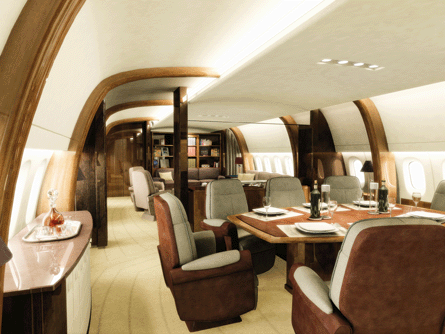These are great times for business aviation. Demand for aircraft is soaring, orderbooks are bulging, and lengthening backlogs promise a welcome safety blanket in the event of an economic downturn.
The appetite for executive aircraft from entry-level to widebody has never been so great. The US General Aviation Manufacturers Association described 2006 as "a banner year" as total deliveries for business jets catapulted to 885, from 750 in 2005, and 2007 should see numbers approach 1,000.
Such market buoyancy is welcome news in this notoriously cyclical industry, but concerns are growing that the rising orders could lead to capacity problems in the completion market, particularly for large-cabin aircraft.
All the established business-jet manufacturers have in-house completion capabilities, many of which are being expanded to keep up with the escalating demand. Gulfstream, which completes its family of business aircraft at five US locations is now in the second phase of a multi-million dollar expansion of its Savannah, Georgia headquarters that is set to double completions capacity at the site.
Dassault is expanding its Wilmington, Delaware and Little Rock, Arkansas facilities, but due to demand for its Falcon business jets the French airframer continues to outsource around 15% of completions to other centres, including Jet Aviation in Basle, Switzerland. Bombardier relies on independents Innotech Aviation in Montreal, Savannah Air Center, and Jet Aviation's St Louis, Missouri-based sister company Midcoast Aviation to complete some of its Challenger and Global families of large-cabin business jets.
|
|---|
Globalisation has stimulated demand for VIP configured airliners such as the ACJ family |
Newcomer Embraer, meanwhile, relies on independent centres to outfit its super mid-size Legacy 600 and large-cabin Lineage 1000 - the first of which is in the final stages of completion at PATS Aircraft in Georgetown, Delaware - but its new Phenom family of very-light and light jets will be completed at the Brazilian manufacturer's new facility at Gaviao Peixoto near Sao Paulo.
Different picture
At the top of the business jet market the picture is radically different. Traditionally builders of commercial airliners, neither Airbus nor Boeing have the performed completion work on narrowbody and widebody aircraft sold for VIP applications, and they remain at the mercy of the bustling independent centres to build and install interiors.
Completion centres are gearing up for the arrival of the 787 and 747-8 in 2010 |
It is in this sector that there is anxiety and frustration with the insufficient slot availability and, in some cases, the inability to perform outfitting work at the same pace that aircraft are rolling out of the factory.
Faced with a growing order backlog of 14 ACJ narrowbodies and at least three widebody A340 VIPs, Airbus earlier this year took the matter into its own hands. Breaking with tradition the airframer resurrected the former Sogerma facility at its Toulouse, France headquarters and this will initially be responsible for completing three ACJs a year.
"The increase in globalisation has pushed up demand for long-range, large-cabin aircraft and Boeing and Airbus sit at the very top of this market," says Norbert Marx, general manager of Jet Aviation's Basel, Switzerland completion centre. In the past, the number of new narrow- and widebody airliners being sold to VIP customers was about equal to the capacity of the independent centres, he says, but now production slots are sold out as far as 2015.
Rather than wait for the new aircraft, Marx says some owners acquire used airliners as an interim measure, for which they want a new customised interior and this is placing a further strain on the completion market. "If you buy a new house, no matter now nice it looks on the inside, you will still want to decorate it to suit your tastes. That is what an owner wants to do with his aircraft," says Marx.
Steve Hill, president of Boeing Business Jets, agrees. "There are well over 100 BBJs and BBJ2s in service today. We plan to deliver 15 aircraft to completion centres over the next two years, but there are no slots available until the second half of 2012." Hill also cites the success of new widebody aircraft such as the 747-8, of which five have already been sold for VIP use with the first deliveries to completion centres scheduled for 2010.
"We are seeing tremendous interest across our range of products particularly for the 787-8/9, which is sold out until 2015. We just wish we could get more aircraft from Boeing to satisfy the demand," Hill says. Boeing has sold around nine 787-8/9s to VIP customers and, with the first aircraft earmarked for delivery in 2010, many completion centres are already gearing up for its arrival. Boeing directs customers to five completions centres it believes have have the skills and structure in place to handle this new generation aircraft: Jet Aviation and Lufthansa Technik (LHT) in Europe and Associated Air Centre (Dallas), Gore Design and Green Point in the USA.
Bottleneck expected
Due to the limited number of centres with widebody completion capability, Hill anticipates a bottleneck in the completion market in 2010. "There will be a flux in deliveries of 787s and 747s and at least two Airbus A340s at that time," he says. "In 2010 there will be around eight different new widebody types loaded into completion centres, and 20 BBJs and ACJs by the following year. Twin-aisle aircraft typically take up more time and more resources to complete and new designs like the 787-8 will take even longer as completion centres go through a learning curve."
Anticipating the arrival of these widebody aircraft, outfitters have launched expansion programmes to handle the extra work. Jet Aviation hopes to secure around a third of the 787 VIP market, and has already signed its first letter of intent, as well as a sizeable portion of A380 VIP completions and has broken ground on a new hangar large enough to simultaneously house an A380 and a 787. The centre is currently completing a 747-400 and an A330 and plans to take delivery of a BBJ and a 757-200 by year-end, as well as 20 Falcon jets.
LHT in Hamburg, Germany is completing major modifications on a 747-300 and an MD-11 and plans to add a second widebody line later this year as well as a second Airbus A318 Elite completion line, with the goal of turning out as many as six a year, says Walter Heerdt, senior vice president for sales and marketing. "We are growing our business and expanding capacity carefully. The last thing we want is overcapacity," he says.
Gore Design, a relative newcomer to the widebody completions business, opened its new 11,000m2 (150,000ft2) hangar three years ago and is planning to add a further 7,500m2. The San Antonio, Texas-based centre is currently completing two BBJs, a 767 and an A320. "This type of growth is unprecedented," says founder and managing director Jerry Gore. "We are talking to three potential 787 customers now and one 747-8 customer, and have already locked in slots for narrow- and widebody aircraft until 2012 - and they're willing to put down substantial, non-refundable deposits to hold them," he says.
Good prospects
Boeing's Hill says while heavy investment is required in these facilities the long-term prospects are good. "No-one wants to relive the after effects of the previous downturn with massive layoffs and empty hangars," he says. "But no one would be prepared to make such a huge investment unless there was a sound business model and a long term future." Hill expects the bottleneck to ease in 2012 "when deliveries will settle to around five new widebodies a year and cycle times shorten as familiarisation increases".
There is a strong future for VIP narrow- and widebody completions both for green and used aircraft, Marx agrees. "Technology and tastes change very rapidly in this business. Customers want the very latest and the best of what is available," he says. "We're seeing interiors with some very complex cabin management systems, and almost every customer is asking for total system integration."
Move or improve
The refurbishment business has benefited smaller and lesser-known facilities that mop up the fall-out from major completions centres forced to turn work away. The Netherlands' Fokker Services, which was appointed by Airbus as a completion centre for its ACJ family, has seen demand for cabin refurbishments increase over the past two years. "We are overwhelmed at the interest we are getting," says business development manager Peter Van Oostrum. "We have one slot available for next year and then we are sold out until 2009. At the moment we perform three refurbishments and green completions a year, but we plan to grow this to seven a year."
Conversions of older regional airliners to executive and shuttle configuration are also providing work. "Aircraft such as the Fokker 100, BAe 146 and Avro RJ series, Saab 340, Dornier 328Jet and Bombardier CRJ200 are "proving particularly popular with customers looking a large-cabin aircraft without the high price tag and long range of a Global Express or G450/550", says Van Oostrum.
Capacity across the refurbishment centres is getting tighter and many customers are forced to wait for slots or look for other alternatives. BAE Systems, which earlier this year delivered to Royal Jet in Abu Dhabi a VIP configured Avro RJ70 completed by Jet Aviation, is now talking to traditional maintenance repair and overhaul companies that are looking to make the add completions to their portfolio. "We expect to place up to seven VIP-configured aircraft [146/Avro types] by the middle of next year," says BAE Systems sales manager Andy Whelan. Five out of seven of these aircraft will be fitted with a combination interior - part VIP and part economy - or business-class seating. "Most of this equipment can be purchased off the shelf and does not require the 'Rolls-Royce' completion service provided by the likes of Jet Aviation and LHT," he says.
While the market remains hot it is tempting for completion centres to squeeze capacity to the limit, but most companies are not prepared to take the risk. "It is important to learn from the mistakes of others," says Jet Aviation's Marx. "During the last market boom [in the 1990s] some centres took on too much work, but they lacked the resources to complete the job on time and were forced to shut down due to the huge financial penalties. We won't let that happen, even if it means turning away more business."
Source: Flight International





















